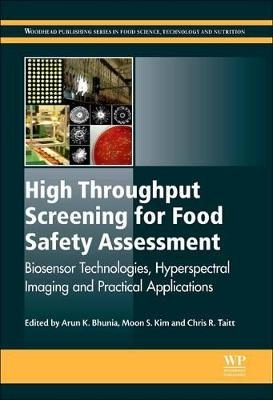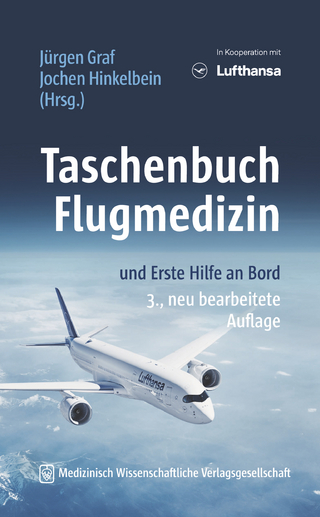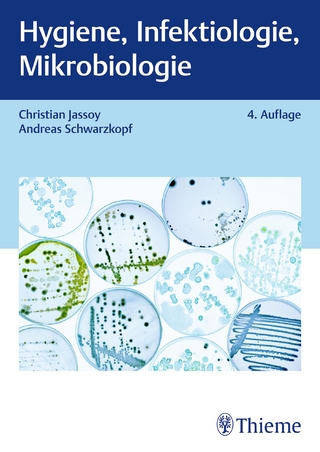
High Throughput Screening for Food Safety Assessment
Woodhead Publishing Ltd (Verlag)
978-0-08-101383-0 (ISBN)
The book first introduces high throughput screening strategies and technology platforms, and discusses key issues in sample collection and preparation. The subsequent chapters are then grouped into four sections: Part I reviews biorecognition techniques; Part II covers the use of optical biosensors and hyperspectral imaging in food safety assessment; Part III focuses on electrochemical and mass-based transducers; and finally Part IV deals with the application of these safety assessment technologies in specific food products, including meat and poultry, seafood, fruits and vegetables.
Arun K. Bhunia is a Professor of Food Microbiology at Purdue University, USA Moon S. Kim is a research physicist with the Agricultural Research Service, USDA, USA Chris R. Taitt is a research biochemist at the Naval Research Laboratory, Washington DC, USA
List of contributors
Woodhead Publishing Series in Food Science, Technology and Nutrition
1. High throughput screening strategies and technology platforms for detection of pathogens: an introduction
Abstract
1.1 Introduction
1.2 Current detection strategies
1.3 Why high throughput screening (HTS) is needed
1.4 HTS technologies for foodborne pathogens – present and future trends
2. Sampling and sample preparation for sensor-based detection of pathogens in foods
Abstract
2.1 Introduction
2.2 Key issues in sample preparation: from “Farm to Fork to Physician
2.3 Challenges in sampling from food matrices and on “bulk surfaces
2.4 Nonspecific vs. specific methods
2.5 Physical methods
2.6 Chemical and combined methods
2.7 Capture and concentration of whole microbial cells
2.8 The use of cleaning materials in sampling
2.9 Capture and concentration of pathogen DNA from complex food matrices
2.10 Innovations in selective enrichment strategies
2.11 Conclusions
Part One: Biorecognition techniques
3. Antibodies, enzymes, and nucleic acid sensors for high throughput screening of microbes and toxins in food
Abstract
3.1 Introduction
3.2 Conventional methods for bacterial pathogen detection
3.3 Rapid and advanced technologies
3.4 Antibody structure and production
3.5 Polyclonal and monoclonal antibodies for biorecognition
3.6 The identification of recombinant antibodies by phage display technology
3.7 Biopanning of phage display libraries
3.8 Biosensors and antibody immobilization strategies
3.9 Immunosensor-based applications for high throughput pathogen screening
3.10 Multiplexed pathogen detection using antibodies for biorecognition
3.11 Nucleic acid assays
3.12 Microarray-based technologies
3.13 Enzyme-based sensors
3.14 High throughput bacterial toxin detection
3.15 High throughput fungal pathogen and mycotoxin detection
3.16 Marine toxins
3.17 Selected commercial platforms for high throughput detection
3.18 Conclusion
4. Phage technology in high throughput screening for pathogen detection in food
Abstract
Acknowledgments
4.1 Introduction
4.2 Pathogen detection using phage: culture-based methods and phage typing
4.3 Pathogen detection using phage: phage-host adhesion-based methods
4.4 Pathogen detection using phage: biosensors
4.5 Pathogen detection using phage: phage-triggered ion cascade
4.6 Pathogen detection using phage: phage replication and metabolism-based methods
4.7 Pathogen detection using phage: phage lysis-based methods
4.8 Conclusion
5. Mammalian cell-based sensors for high throughput screening for detecting chemical residues, pathogens, and toxins in food
Abstract
Acknowledgments
5.1 Introduction
5.2 The need for novel methods in food control
5.3 Cell-based biosensors for food safety
5.4 Mammalian cell-based biosensors
5.5 Robustness and shelf life of mammalian cell-based biosensors
5.6 Conclusions and future trends
Part Two: Optical transducers and hyperspectral imaging
6. Label-free light-scattering sensors for high throughput screening of microbes in food
Abstract
Acknowledgments
6.1 Introduction
6.2 Elastic light-scattering-based high throughput screening of microorganisms
6.3 Application of BARDOT-based high throughput screening in food safety
6.4 Future trends
7. Vibrational spectroscopy for food quality and safety screening
Abstract
Acknowledgments
7.1 Introduction
7.2 Basic concepts of vibrational spectroscopy
7.3 Applications in food quality
7.4 Applications in food safety
7.5 Hyperspectral imaging for food quality and safety
7.6 Summary and future trends
8. Flow cytometry and pathogen screening in foods
Abstract
Acknowledgments
8.1 Introduction
8.2 Analysis of foods using classical flow cytometry
8.3 Analysis of foods using bead-based detection
8.4 Future trends
8.5 Conclusions
9. Fluorescence-based real-time quantitative polymerase chain reaction (qPCR) technologies for high throughput screening of pathogens
Abstract
Acknowledgments
9.1 Introduction
9.2 Basics of real-time qPCR
9.3 Pre-PCR processing
9.4 Instrumentation for qPCR
9.5 Examples of qPCR for high throughput screening of foodborne pathogens
9.6 Future trends
9.7 Sources of further information and advice
10. Fiber-optic sensors for high throughput screening of pathogens
Abstract
Acknowledgments
10.1 Introduction
10.2 General view of immunosensors
10.3 Evanescent field optical biosensors
10.4 Fiber-optic probes and immobilization of ligands
10.5 Application of evanescent wave biosensors for detection of foodborne pathogens
10.6 Conclusions and future trends
Part Three: Electrochemical and mass-based transducers
11. Electronic noses and tongues in food safety assurance
Abstract
11.1 Introduction
11.2 Functioning of electronic noses and tongues
11.3 Food safety applications of electronic noses
11.4 Food safety applications of electronic tongues
11.5 Conclusions and future trends
12. Impedance microbiology and microbial screening strategy for detecting pathogens in food
Abstract
12.1 Introduction
12.2 Impedance for microbiological testing
12.3 Standard impedance
12.4 Specific applications for testing food
12.5 Advantages and disadvantages of impedance testing
12.6 Summary and future trends
13. Immunologic biosensing of foodborne pathogenic bacteria using electrochemical or light-addressable potentiometric sensor (LAPS) detection platforms
Abstract
13.1 Introduction
13.2 Immunoelectrochemistry (IEC)
13.3 Using IEC to detect pathogenic bacteria
13.4 Improving cell capture in IEC and applications in food screening
13.5 Light-addressable potentiometric sensing
13.6 Future trends
13.7 Sources of further information and advice
14. Conductometric biosensors for high throughput screening of pathogens in food
Abstract
14.1 Introduction
14.2 Biosensors
14.3 Conductometric biosensors and gas sensors
14.4 Conductometric biosensors: general and food safety applications
14.5 Future trends and conclusions
15. Microfluidic biosensors for high throughput screening of pathogens in food
Abstract
15.1 Introduction
15.2 Microfluidics
15.3 Immunoassays for pathogen sensing using monoclonal, polyclonal, and recombinant antibodies
15.4 Alternatives to antibodies: immunoassays using molecular imprinted polymers, molecular probes, and aptamers
15.5 Microfluidic immunoassays for detecting foodborne pathogens
15.6 Microfluidic techniques using nucleic acid (NA) analysis
15.7 Lab-on-a-chip (LOC) platforms for NA foodborne pathogen detection
15.8 Microfluidic food processing: sample preparation, isolation, and amplification
15.9 Integrated LOC devices for high throughput screening
15.10 Conclusion
16. Magnetoelastic sensors for high throughput screening of pathogens in food
Abstract
16.1 Introduction
16.2 Freestanding magnetoelastic (ME) biosensors
16.3 Fabrication of ME biosensors
16.4 Biomolecular recognition elements used on ME biosensors
16.5 Interrogation system for ME biosensors
16.6 Applications of ME biosensors as a foodborne screening technique
16.7 Potential applications of the ME biosensor technique along the food chain
16.8 Conclusions
Part Four: Specific applications
17. Total internal reflection fluorescence (TIRF) array biosensors for biothreat agents for food safety and food defense
Abstract
Acknowledgments
17.1 Introduction: waveguides, total internal reflection, and the evanescent wave
17.2 Planar waveguide TIRF array biosensors
17.3 Planar waveguide TIRF arrays in food analysis
17.4 Commercial TIRF array technologies
17.5 Array biosensors for food defense
17.6 Future directions
17.7 Conclusions
18. Online screening of meat and poultry product quality and safety using hyperspectral imaging
Abstract
Acknowledgments
18.1 Introduction
18.2 Fundamentals of hyperpsectral imaging
18.3 The role of spectral techniques in online screening of food
18.4 Implementation of online spectral screening systems for evaluating meat quality
18.5 Key stages in online spectral screening systems
18.6 Using hyperspectral imaging to measure individual meat quality attributes
18.7 Measuring quality in beef and pork
18.8 Measuring quality in lamb, chicken, and turkey
18.9 Measuring quality in fish
18.10 Using hyperspectral imaging to identify bacteria and other types of contaminants
18.11 Using hyperspectral imaging to authenticate meat and meat products
18.12 Conclusions and future trends
19. Online screening of fruits and vegetables using hyperspectral line-scan imaging techniques
Abstract
Acknowledgments
19.1 Introduction
19.2 Line-scan hyperspectral imaging techniques
19.3 Quality and safety evaluation of fruits and vegetables
19.4 Animal fecal contamination on produce
19.5 Hyperspectral/multispectral imaging for online applications
19.6 Whole-surface online inspection of fruits and leafy greens
19.7 Conclusions
20. High throughput screening of seafood for foodborne pathogens
Abstract
20.1 Introduction
20.2 Seafood pathogens and products
20.3 Standard methods
20.4 Nucleic acid-based methods
20.5 Nucleic acid hybridization
20.6 Antibody-based methods
20.7 Matrix-assisted laser desorption/ionization time-of-flight mass spectrometry
20.8 Infrared (IR) spectroscopy
20.9 High throughput screening systems for seafood pathogens
20.10 Future trends
20.11 Additional information
Index
| Erscheinungsdatum | 07.07.2016 |
|---|---|
| Reihe/Serie | Woodhead Publishing Series in Food Science, Technology and Nutrition |
| Verlagsort | Cambridge |
| Sprache | englisch |
| Maße | 152 x 229 mm |
| Gewicht | 730 g |
| Themenwelt | Medizin / Pharmazie ► Medizinische Fachgebiete ► Mikrobiologie / Infektologie / Reisemedizin |
| Technik ► Elektrotechnik / Energietechnik | |
| Technik ► Lebensmitteltechnologie | |
| ISBN-10 | 0-08-101383-3 / 0081013833 |
| ISBN-13 | 978-0-08-101383-0 / 9780081013830 |
| Zustand | Neuware |
| Haben Sie eine Frage zum Produkt? |
aus dem Bereich


